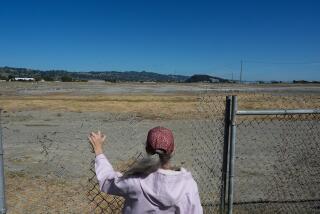Sharp disagreement over effects of North Carolina coal ash spill

Peter Harrison of the Waterkeeper Alliance and Paige Sheehan of Duke Energy discuss the coal ash spill at a closed coal-fired power plant in North Carolina.
EDEN, N.C. — Pete Harrison dipped his kayak paddle into a gray stain on the bank of the murky Dan River. He pulled out a sticky gob 4 inches thick.
“That’s pure coal ash,” he said.
Harrison, a lawyer with the Waterkeeper Alliance, was kayaking the river Thursday to take water samples, four days after a massive plume of coal ash laced with toxic chemicals spilled into the river from a storage basin at a retired coal-fired power plant operated by Duke Energy.
FOR THE RECORD:
Coal ash spill: An article in Section A on Feb. 9 about a coal ash spill in the Dan River in North Carolina said Pete Harrison is a lawyer with Riverkeeper Alliance. The name of the group is Waterkeeper Alliance. —
Environmentalists and the nation’s largest electric utility seem to describe two different rivers in the wake of the third-largest coal ash spill in U.S. history. The Dan River is either recovering just fine or it has been poisoned by pollution from toxic heavy metals that will last for years.
On Thursday, Duke public relations officers in safety helmets and bright yellow vests showed reporters the company’s attempts to plug a ruptured storm water pipe that sent up to 82 tons of toxic coal ash spewing into the river. In calm, soothing tones, they said company tests showed only traces of heavy metals.
From the moment Duke issued its first press release — 26 hours after the spill was discovered at the storage basin Feb. 2 — the utility has downplayed any danger to the public or wildlife. On Friday, a Duke statement was headlined: “Water quality continues to improve.”
Environmental groups say otherwise. A map on the Riverkeeper website uses a skull and crossbones to depict coal ash flows on the Dan, inundated by 27 million gallons of contaminated basin water in addition to the ash itself. Riverkeeper says its tests found levels of arsenic, lead, chromium and other heavy metals far exceeding safety standards.
Pointing to patches of coal ash coating the riverbank, Harrison said the Dan River plant had been leaking heavy metals for years, contaminating groundwater and the river. “That’s just out-in-the-open illegality,” he said.
After environmental groups threatened to sue Duke for leaking coal ash from basins last summer, the North Carolina Department of Environment and Natural Resources sued the utility for illegal discharges of coal ash, a byproduct of burning coal for electricity, from 14 plants in the state, including the Dan River facility.
Duke Energy’s state president for North Carolina, Paul Newton, apologized for the spill. “We will do the right thing for the river and surrounding communities,” he said Friday. “We are accountable.”
Environmental groups have accused state regulators of working too closely with Duke. Frank Holleman, senior attorney at the Southern Environmental Law Center, said of state regulators: “They’re part of the Duke team when they’re supposed to be enforcing the law.”
Jamie Kritzer, a spokesman for the state environmental agency, said, “We’ve been enforcing regulations in state law regarding coal ash since those laws were in place,” including during the Dan River spill.
Tom Reeder, director of the North Carolina Division of Water Resources, said he was concerned about the river’s long-term health. Heavy metals settle and concentrate in sediment on river bottoms.
Coal ash sediment can erupt in hot summer months, sending a plume of toxic metals back into surface water, Holleman said. Lisa Evans, an attorney with the environmental group Earthjustice, compared it to a volcanic eruption in the water.
The state agency began sampling sediment Friday, a day after the EPA began its own sediment sampling.
Earlier, state water tests revealed levels of arsenic, copper, iron and aluminum above state standards for surface water quality. Officials said levels were improving with subsequent test results. Even so, Reeder said, “The Dan River does not have a clean bill of health.’’
The Waterkeeper samples were taken a few yards from the break in the water pipe, where coal ash density is greatest. The Duke and state samples were taken two miles downriver.
“They tested in places where they knew they wouldn’t find high levels of heavy metals,” Holleman said. Kritzer said the state tested downstream because that’s where the effects of the spill are felt.
The EPA has come under fire from environmentalists for dragging its feet on issuing regulations governing storage of coal ash. Pressure mounted on the EPA after a 2008 coal ash spill in Tennessee unleashed a billion gallons of ash slurry, destroying homes and polluting waterways. The EPA warned in 2012 of 45 coal ash storage sites nationally with a “high hazard potential” of dangerous spills.
The agency proposed rules governing disposal and handling of coal ash in 2010 and was sued by environmental groups two years later. Last month, a consent decree required the EPA to finalize the rules by December.
Holleman said the new rules won’t apply to the Dan River coal ash basin or any existing coal ash storage ponds because they cover only new sites. “It’s a ticking time bomb,” he said of heavy metals seeping into groundwater and rivers.
Before the spill, Duke was exploring ways to more safely secure coal ash basins at the Dan River plant and six other retired Duke coal-fired plants in North Carolina, said Duke spokeswoman Erin Culbert. At the company’s seven coal-fired plants still operating, Duke is moving the bulk of ash from basins to more secure lined landfills, Culbert said.
For North Carolina Gov. Pat McCrory, the spill has presented a delicate political challenge. McCrory, a Republican, worked for Duke Energy for 28 years. He helped lead a Republican takeover of state government that advocates repealing or softening environmental regulations and cutting taxes for business and industry.
McCrory made no public statements on the spill until Thursday, when he showed up at the Dan River plant. Citing Duke and state water test results, the governor said authorities were “pretty confident the water is very safe.”
He added: “There should be no expense spared by Duke Energy to clean this up and take all action necessary to make sure it doesn’t happen again.”
Asked whether Duke faced fines or other sanctions, the governor sidestepped the issue, saying it was too early to make that decision.
Opinion is also divided over whether Dan River water is safe downriver in Virginia. In Danville, Va., the downstream city closest to the spill, officials say normal filtering of river water had rendered drinking water safe. But Virginia Beach stopped drawing water from Lake Gaston, fed by the Dan River. Virginia Beach is more than 200 miles from the spill.
Late Friday, Duke announced that workers had begun recirculating ash and water from the ruptured pipe to try to divert it back into the basin and away from the river.
A mile or so downstream, Harrison had just pulled his kayak out of the water at dusk. Even with the leak stopped or slowed, he said, damage has been done.
“We still need to know what the sediment load is, what happened to the coal ash plume and so on,” Harrison said. “There’s a lot we still don’t know.”
More to Read
Sign up for Essential California
The most important California stories and recommendations in your inbox every morning.
You may occasionally receive promotional content from the Los Angeles Times.











